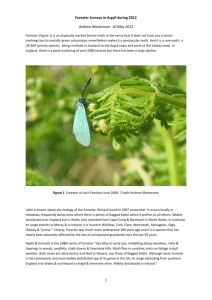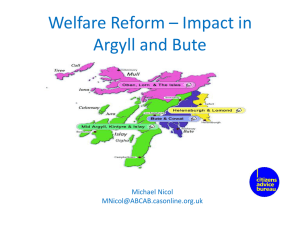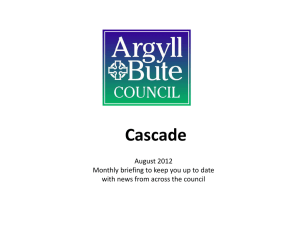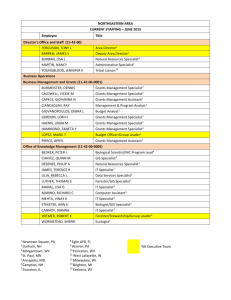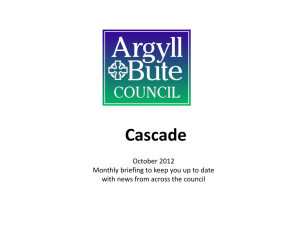Forester Surveys in Argyll 2014
advertisement
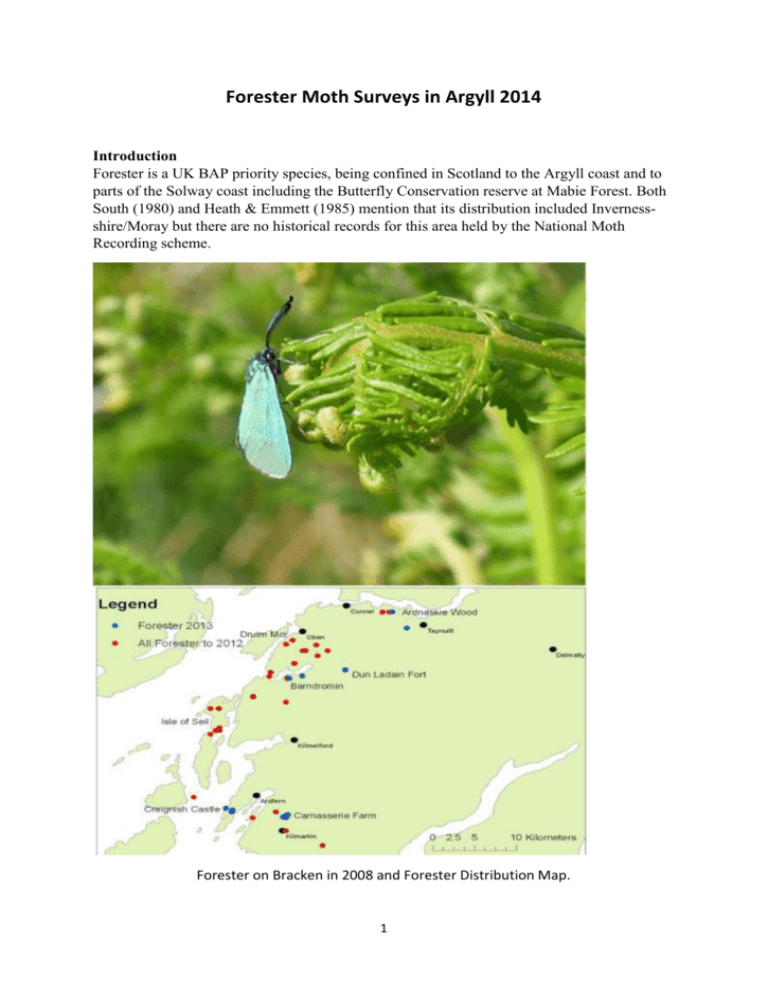
Forester Moth Surveys in Argyll 2014 Introduction Forester is a UK BAP priority species, being confined in Scotland to the Argyll coast and to parts of the Solway coast including the Butterfly Conservation reserve at Mabie Forest. Both South (1980) and Heath & Emmett (1985) mention that its distribution included Invernessshire/Moray but there are no historical records for this area held by the National Moth Recording scheme. Forester on Bracken in 2008 and Forester Distribution Map. 1 In Argyll, Forester is found in three main areas: around Oban; the Isle of Seil and Kilmartin All sites are therefore quite coastal but in England, Forester also occurs inland. Although there is a good scattering of post 2000 records in England, there has been a large decline during the 20th century which has been attributed to the loss of un-improved grassland. This fact is an important indicator of its general habitat requirements which are not well understood. Distribution of Forester in the UK showing an inland distribution in England, Wales and Northern Ireland but coastal distribution in Scotland (gold squares: pre-2000; blue squares: post-2000). Credit: National Moth Recording Scheme Heath & Emmett (1985) write of Forester “late May to early July, inhabiting damp meadows, rides & clearings in woods, sandhills, chalk downs & limestone hills. Moth flies in sunshine, rests on foliage in dull weather. Both sexes are attracted to and feed at flowers, especially those of Ragged Robin. Although local, Forester is the commonest and most widely distributed species of its genus in the UK, its range extending from southern England into Wales & northward to Argyll & Inverness-shire. Widely distributed in Ireland.” 2 Waring & Townsend (2003) says “flies in sunshine, both sexes spend much time feeding at flowers such as Ragged Robin, Field & Devil’s-bit Scabious, clovers & Viper’s Bugloss, even in cloudy weather. Mating pairs are seen in the afternoon and males sometime fly again an hour or so before sunset on warm evenings. Open habitats, ranging from damp neutral grassland to limestone grassland, chalk downland, acid and sandy heathland, mature coastal sand-dunes and woodland rides & clearings.” Of distribution, Waring & Townsend (2003) writes “Local & well distributed in England & Wales where many colonies have been lost as a result of intensification. Very local in western Scotland, in Argyllshire and the islands of Jura, Lismore & Mull. Widespread but local in Ireland.” Kate Findlay’s MSc Thesis on Forester’s habitat requirements During June 2013, an undergraduate, Jack Higgs, and a postgraduate, Kate Findlay, from the University of Kent visited three areas of the UK to attempt to characterise the habitat requirements of Forester: chalk and limestone downland in Dorset; heath and woodland rides in East Anglia; and damp grassland in Argyll. To date, only Kate Findlay’s work has been written up (Findlay, 2013), and her results are discussed below. Ten Argyll sites with historical Forester records in the last ten years were visited and Forester was found at three: Dun Ladain Fort (2); Carnasserie Farm (3); and Barndromin (1). In England, Forester was found at nine of 23 sites which indicates that a single visit to a historical Forester site in England has a 39% chance of detection compared with 30% in Scotland. Both results are good and provide encouragement for further Forester surveys. A number of habitat variables were determined for each site using data recorded within 30 1 m2 quadrats at 10 m intervals along a structured walk: sward height measured with a drop disc; sward height variability; percentage disturbance; percentage tree or shrub cover; Common Sorrel density; Common Sorrel patchiness; and flower density. Management information was also obtained; presence/absence of mowing and grazing including grazing spp; and whether or not site was protected with a conservation designation. Each site was given a score of suitability for Forester based on the presence/absence of Forester in 2013 and the number of years since the last record of Forester. Multiple regression was then used to determine the best explanatory variables. Owing to problems with correlations between explanatory variables, not all variables could be used in these analyses. The best models were found to be those that included percentage tree or shrub cover alone and percentage tree or shrub cover and whether or not a site was protected: less tree/shrub cover favoured suitability as did a conservation designation. The adverse effects of tree/shrub encroachment on grassland butterflies and Burnet moths has been documented in Sweden where increased tree cover was associated with decreased numbers of vascular plants and butterflies (Öckinger et al., 2006). For Forester, lack of tree/shrub cover is important as it provides open sunny habitats together with abundant nectar plants. The importance of Protected sites as a factor favouring Forester offers support for the hypothesis that suitable habitat is herb-rich as Nature Reserves are generally special herb-rich 3 places associated with high a biodiversity of both plants and animals. One of Kate Findlay’s explanatory variables was flower density and it is interesting that Carnasserie Farm where both the author and Findlay found three Foresters was the most flower-rich site of the 33 sites surveyed at 16.5 flowerheads per m2 while 15 sites had values less than one. As Findlays’s Flower variable was the mean number of flower heads (of selected known nectar plants of Forester) per 1 m 2 quadrat averaged across 30 during a structured walk, it is probably not a good indicator of the presence of herb-rich areas at a site which may comprise small localised patches. It is possible as was the case with the three sites surveyed by the author that small areas of herb-rich habitat occurred within a mosaic of habitats at the 33 sites. Further evidence of the importance of herb-richness to Forester is provided by a study of specialist moths in the Brecklands (Hearle & Ellis, 2012). The study investigated the effects of different methods of creating bare ground on a range of specialist moths including Forester. Forester was attracted to the abundant nectar that appeared on many plots and was found on 20% of plots created. The fact that Forester occurs at some Transparent Burnet sites also supports the argument that Forester needs herb-rich habitats as surveys in 2013 found Transparent Burnet sites on mainland Argyll to be herb-rich (Masterman, 2013). Summary of known habitat requirements of Forester The main conclusion of the author’s research to date is that Forester inhabits herb-rich sites with abundant nectar plants. What little has been written on Forester does tend to use the adjective “damp” rather than “wet” to describe its grassland habitat and success in characterising its habitat might depend on being able to differentiate meadows and other sites such as lower slopes of escarpments and stream edges which are damp rather than wet. Common Sorrel and Ragged Robin may be less abundant in such damp habitats than in wet examples and this characteristic could be key in identifying sites with suitable habitat for Forester. Of course, finding larvae would be the ultimate proof of Forester habitat requirements but this is apparently difficult. The photo below shows a fully-grown Forester caterpillar reared by Roy Leverton and searches on Common Sorrel in late April/early May could yield similar caterpillars. A more practical approach is to continue to record site and vegetation data within a 5m radius of an adult Forester observation to build a database of Forester site characteristics. The survey pro-forma has been improved to include a soil moisture category of damp and a score for slope and aspect. Another approach is to test hypotheses about topographical features favouring Forester by locating such features near to historical Forester records and searching for Forester at these sites. Lower parts of steep escarpments like at Carnasserie Farm and at Transparent Burnet sites Edges of streams which tend to be both damp and herb-rich 4 Slightly raised drier herb-rich areas in wet meadows with rank Common Sorrel and Ragged Robin. It might be the case that Forester is quite common in coastal Argyll if you know where to look. It is not very conspicuous like Transparent Burnet and you will have little chance of noticing it unless you are within a few metres of one. But with an understanding of its habitat requirements, it might be fairly easy to identify potential new habitats and discover new sites. Final-instar Forester larva reared by Roy Leverton. Andrew Masterman 5 5 March 2014 References Findlay, K., 2013. Habitat requirements of the Forester moth (Adscita statices). Unpublished MSc Thesis to University of Kent. Hearle, S and Ellis, S. 2012. Specialist moths in Breckland: creating bare ground habitat on landscape-scale. Landscape-scale conservation for butterflies and moths. Butterfly Conservation, Dorset, UK. Heath, J. and Emmett, A. M., 1985. The Moths and Butterflies of Great Britain and Ireland, Vol 2. Harley Books. Masterman, A., 2013. Transparent Burnet Surveys in Argyll in 2013. Unpublished Report to Butterfly Conservation. Öckinger, E., Eriksson, A. K. and Smith, H. G., 2006. Effects of grassland abandonment, restoration and management on butterflies and vascular plants. Biological Conservation 133:291–300 South, R. 1980. The moths of the British Isles. Frederick Warne & Co Ltd. Waring, P. and Townsend, M., 2003. Field Guide to the Moths of Great Britain and Ireland. British Wildlife Publishing. 6 Table of all Forester records in the VC98 moth database ordered chronologically Site Gridref Quantity Date Recorder Method Stage Argyll>Loch Craignish>Eilean Righ NM8001 0 1899 Tutt Unknown Not recorded Argyll>Oban>Loch Nell NM8927 0 1899 Tutt Unknown Not recorded Argyll>Oban>Upper Soroba NM8627 0 1960 Pelham-Clinton, E.C. Unknown Not recorded Argyll>Seil NM760180 0 1960 Pelham-Clinton, EC Field record/ observation Adult Argyll>Loch Feochan>Minard>Ardentallan NM822236 0 1975 Langmaid, Dr J. Unknown Not recorded Argyll>Oban>Minard>Ardentallan NM8223 0 1978 Langmaid, J. & Agassiz, D. Field Record Adult Argyll>Seil>Ballachuan NM756146 0 1990 Young, Dr M. Unknown Not recorded Argyll>Seil>Ballachuan NM761146 0 1995 Christie, I. Unknown Not recorded Argyll>Seil>Ballachuan NM760148 0 1995 Barbour, Dr D. Unknown Not recorded Argyll>Kilmichael Glen>Creag Bhreac NR884967 1 2009 Corinne Mills field observation Adult Argyll>Seil NM760180 0 24-Jun-47 Downes Field record/ observation Adult Argyll>Oban>Kilbride NM8525 4 15-Jun-57 Pelham-Clinton, E.C. Daytime observation Adult Argyll>Oban>Upper Soroba NM864270 0 15-Jun-57 Pelham-Clinton, E.C. Unknown Not recorded Argyll>Seil NM7514 0 14-Jul-63 Pelham-Clinton, EC Field record/ observation Adult Argyll>Seil>Druim Buidhe NM7518 1 14-Jul-63 Pelham-Clinton, E.C. Daytime observation Adult Argyll>Oban>Kilbride NM8525 ? 14 24-Jun-78 Clifford Edwards Field Observation Adult Argyll>Oban>Kilbride NM8525 ? 1 27-Jun-79 Clifford Edwards Field Observation Adult Argyll>Oban>Druim Mor NM8428 1 08-Jun-82 Clifford Edwards Field Observation Adult Argyll>Kilmartin>Carnassarie NM8401 0 07-Jun-84 Raymond, J. Unknown Not recorded Argyll>Seil>Loch Seil NM801198 0 27-Jun-84 Wormell, Mr P. Unknown Not recorded Argyll>Connel>Achnacloich NM956330 0 01-Jun-86 Barbour, Dr D. Unknown Not recorded Argyll>Connel>Achnacloich NM956330 0 01-Jul-97 David Barbour Field record / observation Not recorded Argyll>Seil>Loch Seil NM801199 7 07-Jun-04 John Knowler Field record / observation Not recorded Argyll>Oban>Barndromin NM842228 1 22-Jun-04 Jamie Mellor Not recorded Adult Argyll>Loch Feochan>Moleigh>Kilmore NM878262 10 01-Jun-06 Pete Hardy Not recorded Adult Argyll>Connel>Ardnaskie NM964330 0 01-Jun-06 Bob Black Not recorded Adult Argyll>Seil>Loch Seil NM801199 8 01-Jun-08 Bill Jackson Field Observation Adult 7 Argyll>Oban>Barndromin NM842226 2 03-Jun-08 Andrew Masterman 8. On vegetation Adult Argyll>Scarba NM730042 1 13-Jun-08 Stephen Mason Field Observation Adult Argyll>Kilmartin NR84009901 1 23-Jun-08 Carl Farmer Field Observation Adult Argyll>Oban>Kilninver NM8419 1 13-Jun-10 Clive Craik Field Observation Adult Oban>Druim Mor NM848286 1 19-Jun-10 Steve Murphy Field Observation Adult Argyll>Seil>Ballachuan NM76071499 1 20-Jun-10 Carl Farmer & Scottish Wildlife Trust Field record / observation Adult Argyll>Oban>Lochan a'Bhuilg Bhith, nr NM87632790 1 26-Jun-10 Carl Farmer Field record / observation Adult Argyll>Kilmartin>Carnassarie Farm NM83870111 2 27-Jun-10 Prescott Tom, Leverton Roy & Huff Amy et al field observation Adult Argyll>Kilmartin>Carnassarie Farm NM838012 2 27-Jun-10 Prescott Tom, Leverton Roy & Huff Amy et al field observation Adult Argyll>Kilmartin>Carnassarie NM82790190 1 20-Jul-10 Carl Farmer Field record / observation Adult Argyll>Glen Feochan>Dun Ladain Fort NM911240 1 06-Jul-11 Zoe Clelland Field Record Adult Argyll>Glen Feochan>Dun Ladain Fort NM9112524031 2 16-Jun-13 Kate Findley Field Record Adult Argyll>Taynuilt>Ardnaskie Wood NM9674933030 1 16-Jun-13 Ian McPherson Field Observation Adult Argyll>Ardfern>Craignish Castle NM768025 1 17-Jun-13 Simon Gregory Field Observation Adult Argyll>Ardfern>Craignish Castle NM775019 1 17-Jun-13 Simon Gregory Field Observation Adult Argyll>Loch Feochan>Barndromin NM8441722660 1 19-Jun-13 Kate Findley Field Record Adult Argyll>Kilmartin>Carnasserie Farm NM8366901122 2 19-Jun-13 Kate Findley Field Record Adult Argyll>Kilmartin>Carnasserie Farm NM8402601041 1 19-Jun-13 Kate Findley Field Record Adult Argyll>Ardfern>Craignish Castle NM7757301942 1 24-Jun-13 Andrew Masterman Field Observation Adult Argyll>Ardfern>Craignish Castle NM7757501944 1 24-Jun-13 Andrew Masterman Field Observation Adult Argyll>Kilmartin>Carnassarie Farm NM8418101484 1 24-Jun-13 Andrew Masterman Field Observation Adult Argyll>Kilmartin>Carnassarie Farm NM8418401504 1 24-Jun-13 Andrew Masterman Field Observation Adult Argyll>Kilmartin>Carnassarie Farm NM8422001478 1 24-Jun-13 Andrew Masterman Field Observation Adult Argyll>Loch Feochan>Barndromin NM8597223046 1 26-Jun-13 Jamie Mellor Field Observation Adult Argyll>Ardfern>Craignish Castle NM776022 2 07-Jul-13 Simon Gregory Field Observation Adult 8
